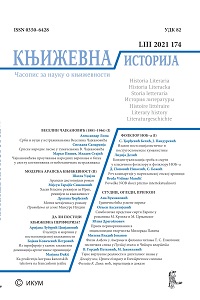Срби и вуци у истраживањима Веселина Чајкановића
he Serbs and the Wolves in Veselin Čajkanović’s Studies
Author(s): Aleksandar LomaSubject(s): Serbian Literature
Published by: Институт за књижевност и уметност
Summary/Abstract: Veselin Čajkanović dedicated a quarter-century, between 1921 and his death in 1946, to reconstructing the pre-Christian religion of the Serbs. From the very outset, he paid particular attention to the special significance of the wolf in the Serbian folk tradition, eventually coming to the conclusion that the supreme god of the Serbs goes back to their mythical ancestor, imagined initially in a theriomorphic, wolfish form. Such a totemic manistic approach is nowadays hardly convincing. Čajkanović failed to notice the essential fact determining the position of the wolf in the traditional worldview, present since the origins of humankind. The wolves are perceived by humans collectively, as they are highly social animals with a strong hierarchy and determined roles within their packs. This predestined them not only to be domesticated under the name of dogs as early as the paleolithic age, long before any other animal species but also to serve as a model for human behaviour, at first in collaborative hunting and later also in war. Among the Indo-European peoples, the wolfish behaviour used to be imitated by the adolescents passing the rites of the warrior initiation. Their yearslong training ended sometimes with a whole generation of these young “wolf warriors” being expelled from the community in order to find themselves elsewhere a new home and rape wives – which was, inter alia, the pattern of the early Greek colonization and of the Italic ver sacrum – or to scout foreign countries as the first step towards a large-scale migration. A memory of the warrior’s bands of this kind, behaving wolfishly and disguising themselves as wolves, survives in the European folklore as the werewolves, i.e. lycanthropes, whom Čajkanović (as well as many others) erroneously identified with vampires, i.e. the walking dead, whereas they were originally living humans temporarily transformed into wolves. The epic figure of a prince-sorcerer endowed with lycanthropic traits can be traced back to the Common Slavic past, primarily based on the comparison of the Vseslav of Polotsk, Volh Vseslavjevič of the Russian byliny, with the Despot Vuk Grgurević, ZmajOgnjeni Vuk (‘Wolf the Fiery Dragon’) of Serbian heroic songs, but also the popular legend of Saint Sava, the patron saint of Serbia, who seems to have assumed some themes and motifs originally connected with this pagan type of hero, which inspired Čajkanović to put forward the hypothesis that among the Serbs a wolf became a Christian substitute for their pagan supreme god.
Journal: Књижевна историја
- Issue Year: 53/2021
- Issue No: 174
- Page Range: 13-44
- Page Count: 30
- Language: Serbian

